613 Search Results for a year of core
December 10, 2014
by Carole Zangari -
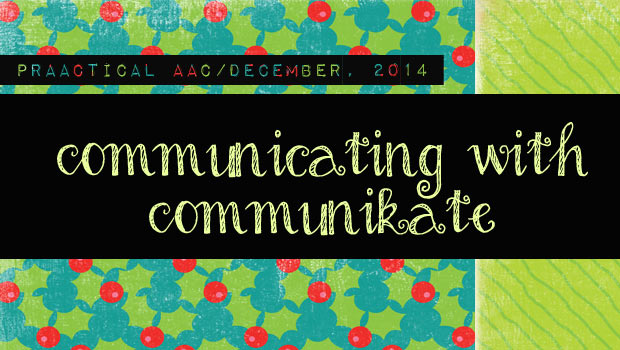
We’ve talked a lot about innovative communication displays and today we’re going to highlight a recently released one. I was delighted to hear about CommuniKate from Dr. Joe Reddington, who blogs at joereddington.com. Joe is a principal of White Water Writers, a project that trains teachers and youth leaders to run inspiration literacy camps, and works toward a world where all children can hold books they have written. He researches ethical issues around power and control in the context of communication disability, and produces open datasets for AT provision, among other things. In this post, Joe introduces us to CommuniKate. CommuniKate 20 is a socially focused page set designed exclusively for people who use augmentative and alternative communication (AAC). It was designed so that it could be easily used in conjunction with a low-tech communication book and as a progression from a book to a dynamic display device. It covers core vocabulary and... [Read More...]
October 16, 2014
by Carole Zangari -
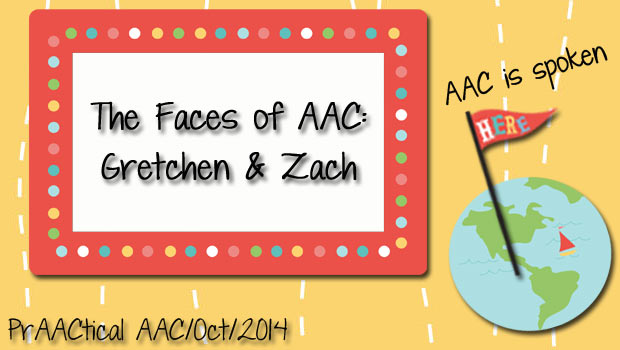
From Bielsko, Poland, to Denver, USA, we are continuing to share the Faces of AAC. Today, we meet SLP Gretchen Storm, who works in the public school system and has a private practice. Gretchen enjoys collaborating with parents, children, teachers, other healthcare providers, siblings and peers in strategies and facilitating communication through speech generating devices. In this post, Gretchen introduces us to Zach. :::::::::::::::::::::::::::::::::::::::::::::::::::::::::: Zach is an 11 year old who uses a Tobii I-12 eye gaze communication device to communicate. He previously used a switch scanning method on a VMax from Dynavox. Zach recently switched to an eye gaze device. Though he loves to use his arms and hands whenever possible, his motor control of them is not ideal for the consistent switch access needed for switch scanning. He was switched to an eye gaze system which could also serve as a switch scanning device if in the future he demonstrates improved... [Read More...]
September 4, 2014
by Carole Zangari -
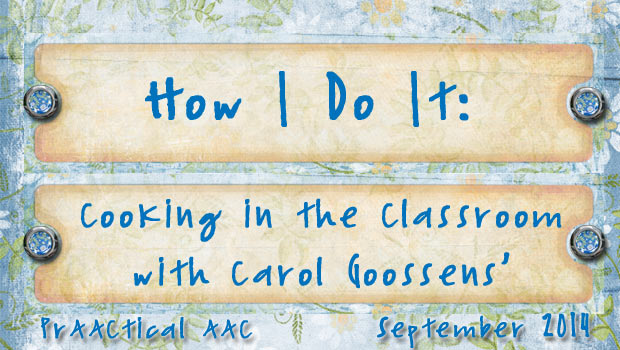
There is something about fall that puts us in the mood for cooking. Today, we are honored to learn from an AAC pioneer, Dr. Carol Goossens,’ who is an SLP and special educator based in the New York City area. She has consulted extensively in a variety of classrooms serving the full spectrum of children with special needs. Carol has presented both nationally and internationally about her collaborative work with teachers, therapists and families. She is known for her ability to seamlessly integrate technology in the classroom and for developing innovative ways to help children learn …while having fun doing it! In this post, she shares one of her latest projects, making animated recipes for using in cooking activities in the classroom. Cooking appears to be motivating for most children … the magic of putting together ingredients that ultimately become something delicious to eat. Teachers, speech-language pathologists (SLPs) and occupational therapists (OTs) often use food preparation activities... [Read More...]
August 12, 2014
by Carole Zangari -
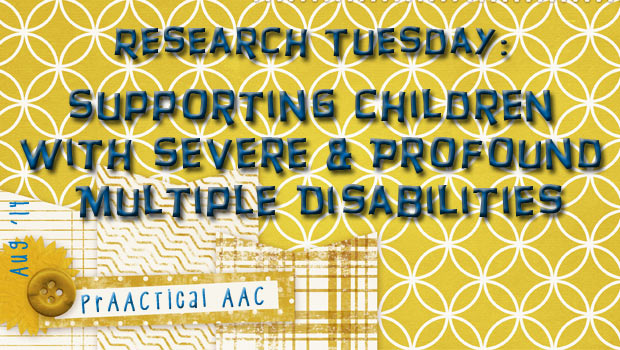
What do we know about the best ways to provide communication support to individuals with severe and profound multiple disabilities (PMLD)? PMLD is a term that generally refers to people who experience profound cognitive limitations in addition to sensory and/or physical disabilities. Many of these individuals have complex medical histories and chronic health concerns. Often, the communication difficulties experienced by individuals with PMLD cause them to be isolated and excluded from many social and educational opportunities. Despite their many challenges, there is evidence to suggest that AAC supports can help these children develop their communication skills. Not much is known, however, about how to structure the AAC intervention to maximize learning. In this study, Harding and her colleagues sought to reduce isolation and promote personal autonomy by providing AAC supports to two children with PMLD. As other researchers have demonstrated the positive impact of AAC on people with PMLD, this... [Read More...]
July 8, 2014
by Carole Zangari -
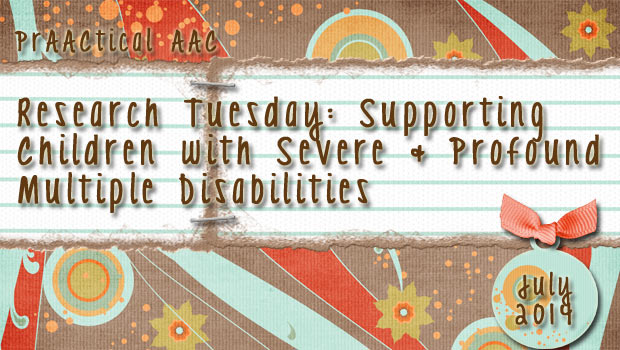
What do we know about the best ways to provide communication support to individuals with severe and profound multiple disabilities (PMLD)? PMLD is a term that generally refers to people who experience profound cognitive limitations in addition to sensory and/or physical disabilities. Many of these individuals have complex medical histories and chronic health concerns. Often, the communication difficulties experienced by individuals with PMLD cause them to be isolated and excluded from many social and educational opportunities. Despite their many challenges, there is evidence to suggest that AAC supports can help these children develop their communication skills. Not much is known, however, about how to structure the AAC intervention to maximize learning. In this study, Harding and her colleagues sought to reduce isolation and promote personal autonomy by providing AAC supports to two children with PMLD. As other researchers have demonstrated the positive impact of AAC on people with PMLD,... [Read More...]
April 10, 2014
by Carole Zangari -
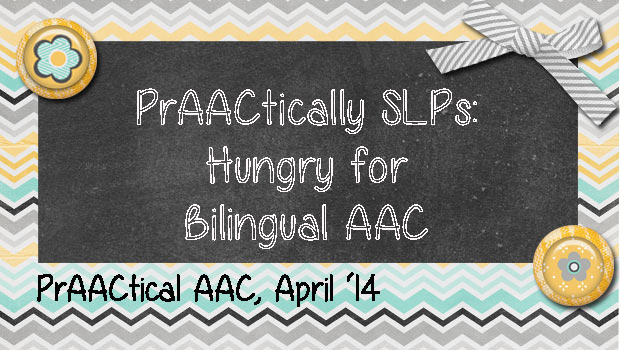
We are so excited to launch, PrAACtically SLPs, a new series featuring the voices of graduate students in SLP programs who do outstanding work in AAC. We start off with a wonderful group from the University of North Carolina at Chapel Hill. Allie Rodriguez, Caitlin Rich, and Megan Latta are second year SLP students who will be graduating in May. They recently concluded an AAC course taught by Dr. Penny Hatch, who continues to mentor them in the field of AAC and literacy. I met these energetic young professionals at the North Carolina Augmentative Communication Association Conference in February and was inspired by their passion. In this post, they tell us about their AAC experiences on a trip to Guatemala. Hungry for Bilingual AAC? Today, our population is becoming more culturally diverse, which, in turn, has caused our caseloads to reflect this change. There is a growing... [Read More...]
April 3, 2014
by Carole Zangari -
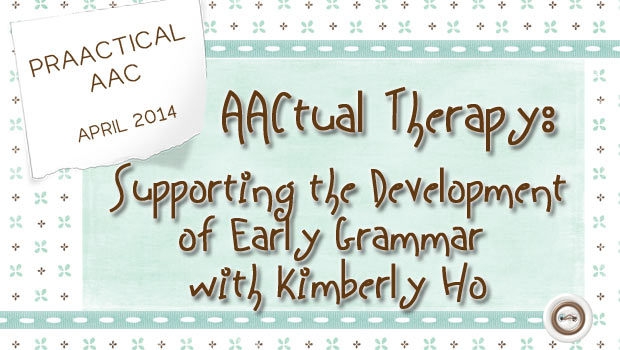
Our guest post for today is from SLP Kimberly Ho, an AAC specialist who operates a private practice, AAC Services. I met Dr. Ho many years ago when she was getting her master’s degree at Purdue University. She went on to get her doctorate and now consults for a number of public schools and works with individuals with AAC needs from preschoolers to adults. Kimberly is active in teaching (undergraduate and graduate courses), writing (published three articles in peer reviewed journals) and public speaking (15 presentations at regional, national and international conferences). In this post, she discusses some concepts in teaching grammar to people who are learning AAC. Traditionally, individuals with complex communication needs (CCN) were provided with communication boards or speech generating devices (SGDs) filled with topic specific vocabulary often called fringe words. The field of AAC is only just beginning to provide early communicators with access to Core... [Read More...]
March 7, 2014
by Carole Zangari -
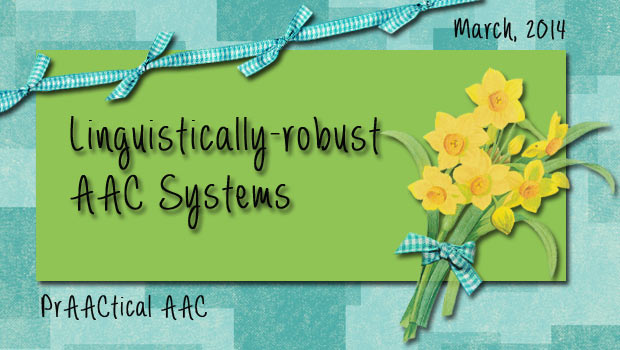
At the NCACA conference last month, a few of us were talking about what it means to have an AAC device or app with a strong language system, something Gail Van Tatenhove and I wrote about a few years ago in this book. Linguistically-robust language systems are those that will allow someone to construct grammatically correct utterances. Think of the different SGDs or AAC apps that you worked with this week. If you could use them to recreate the last 30 minutes of ‘talk time’ that you had without spelling out too many of the words, chances are pretty good that it is a linguistically-robust system. That led to us asking ourselves and others a question. “What do you look for in terms of a language system when you’re considering SGDs or AAC apps for a learner who has the potential to (eventually) construct grammatically correct utterances?” Keep in mind... [Read More...]
February 6, 2014
by Robin Parker -
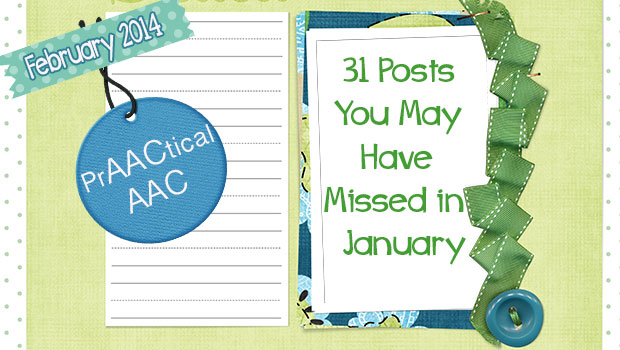
Strategy of the Month: PrAACtice Opportunities Building a PrAACtice Routine PrAACtical Communication Opportunities in SLP Sessions Using Aided Language To Build Communication Opportunities PrAACtical Excercise: Building Fluency with Decontextualized PrAACtice PrAACtical Thinking Ringing in the New Year with an AAC App Giveaway- acorn Another Year of Core Vocabulary Get Organized for the New Year- 5 Visual Schedule Apps A PrAACtical Week: 2014 #1 Watch it Wednesday- Pain in Children with Developmental Disabilities PrAActical Peek: Decorating Cookies 31 Posts You May Have Missed in December A PrAACtical Week 2014 #2 Does AAC Really Work with Infants & Toddlers Watch it Wednesdays- Using and Creating Routines to Promote Interactions Throwback Thursday: Visual Schedule Roundup A PrAACtical Note of Appreciation A PrAACtical Week 2014 #3 Watch It Wednesday: I Hear Them All A Totally Different Life A PrAACtical Week #4 SpeakAll! A Research-to-Practice Project Make It PrAACtical: Make Your Own Battery Interrupter (Without Soldering) ... [Read More...]
January 17, 2014
by Carole Zangari -
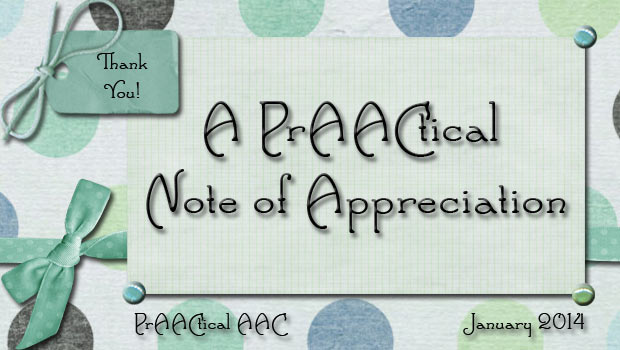
We usually don’t make a fuss over blog birthdays or anniversaries, but this milestone seemed like something worth celebrating. Yesterday, you helped us hit a milestone: Our prAACtical pages have been viewed well over 500,000 times. It’s fun to think of people reading our posts, but this is bigger than us. The ‘AAC message’ is being heard and the AAC community is growing. In every continent, there are SLPs, educators, parents, paraprofessionals, and organization leaders who are giving voice to people who struggle to express themselves. Today, we celebrate YOU! Thanks for the work you do, and for being part of a community that believes everyone has both the right and the ability to communicate. We so enjoy connecting with you and hearing about your prAACtical experiences. Please enjoy these downloadable resources that we’ve developed and shared over the past two years. Forms: Need to flesh out your resources for... [Read More...]









